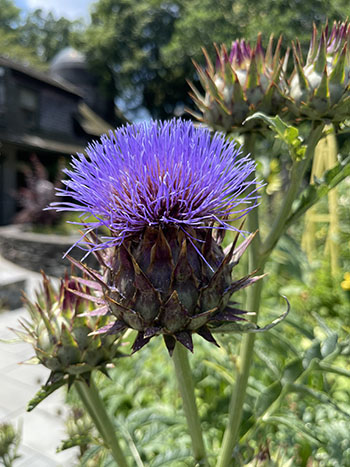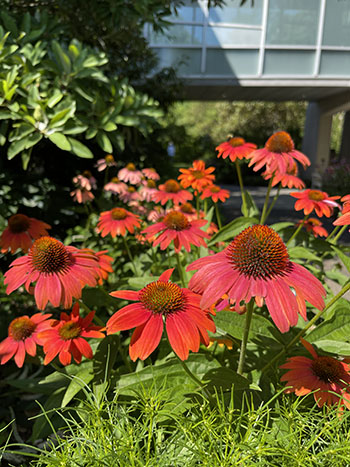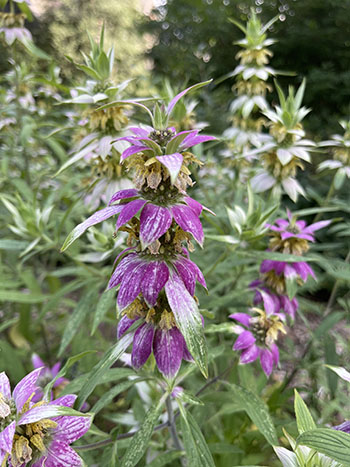
Plants of the Week: July 18
Guest Author: Summer Intern Payton Fulton

Cynara cardunculus, commonly called cardoon, makes a dramatic statement in the sunny perennial border. It is a fast-growing perennial in the Asteraceae family native to the western and central Mediterranean. It has prickly, deeply cut, gray-green foliage and tall flower stalks topped with brilliant purple flowers. While it is a perennial, it is often grown as a half-hardy annual. The attractive foliage starts out silver, becoming a gray-green as it grows. The leaves can reach lengths of up to 3′ and as the leaves age, they can begin to lose their upright form. To keep a neat appearance, trim off the older leaves.
Cynara cardunculus needs rich, well-drained, moist soil and full sun to grow. Leaf stalks and roots are blanched, harvested, cooked, and eaten as vegetables. Bees, butterflies, and other pollinators love them; the unique blossoms are terrific in a fresh or dried arrangement. Sculptural and incredibly eye-catching, it makes a dramatic statement in the garden. Take a look at Cynara cardunculus in the Scott Entrance Garden. Photo credit: P. Fulton

Echinacea’ Cheyenne Spirit’, called coneflower, has been cultivated as a perennial in the Asteraceae family. Native to the central and eastern part of the country, indigenous groups used it to cure wounds and infections. Its bright and large blossoms made a successful transition to the backyard.
‘Cheyenne Spirit’ was introduced by Kieft-Pro Seeds in 2012. It is a well-branched, sturdy coneflower that won the 2013 AAS (All-America Selections®) award and Europe’s FleuroSelect Gold Medal for garden performance. It comprises rich shades of cream, golden yellow, orange, purple, rosy-red, scarlet, and tomato-red. The flowers develop atop very sturdy stems in mid-summer. Grows up to 24-30 in tall and 12-24 in. wide. It thrives in full sun, dry to medium moisture, well-drained soils. Tolerant to drought, heat, and humidity. This is a perfect choice for borders, meadows, wildflower gardens, or a cottage garden that will attract beneficial pollinators; butterflies, hummingbirds, bees, and other pollinators; it is deer-resistant. Give some attention to this vibrant perennial in the Pollinator Garden Photo credit: P. Fulton

Monarda punctata, called spotted bee balm, is a clump-forming, short-lived perennial or annual wildflower in the Lamiaceae family and is native to the eastern U.S. In summer, plants are topped by showy rounded clusters of creamy purple-spotted tubular flowers. Leaf-like pink, lavender, or creamy bracts from beneath each flower cluster growing 2-3’ tall in full sun or partial shade and well-drained sandy or loam soil. The stacked combination of colored bracts and speckled flowers is unique and showy. It attracts butterflies, hummingbirds, and other beneficial pollinators to the garden and is an excellent choice to put in the gardens as it is deer and rabbit resistant. The aromatic leaves may be used to flavor teas.
Monarda punctata is best suited for wild gardens, prairies, meadows, and herb gardens. If you ever plan on bringing Monarda punctata into your home, be aware of powdery mildew, a severe problem with Monarda, particularly in crowded garden areas with poor air circulation. Have a chance to check out Monarda punctata along College Avenue. Photo credit: P. Fulton





Robert Roggeveen
Posted at 09:45h, 03 AugustThree great suggestions. I have the Monarda punctata in bloom in my garden here in central Connecticut. ‘Cheyenne Spirit’ is an outstanding red. I have to try the Cynara in 2023. What a great resource this ‘column’ can be. Thank you.